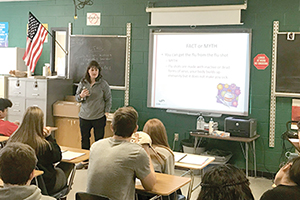By RENEE STOVSKY
Half of all adults in the United States have inadequate skills to understand their health care options, according to the Centers for Disease Control and Prevention.
And that lack of health literacy is linked to higher rates of hospitalization, reduced preventive care and increased health costs, claims a 2017 study, "Improving Health and the Bottom Line: The Case for Health Literacy," by the University of Missouri Center for Health Policy and the Department of Media and Information at Michigan State University.
Increasing health literacy, say the report's authors, can enhance quality of care, benefit population health, improve patient and provider experiences, and reduce health costs.
SSM Health Dean Medical Group in Madison, Wis., takes that message seriously. Based on the belief that health literacy should begin early, it has been providing an employee to teach a two-hour health literacy curriculum over two days each semester at James Madison Memorial High School.

Anne Marie Nahn Bell teaches the basics of health literacy to a class of 15-year-olds at James Madison Memorial High in Madison, Wis. Bell is a physical therapist and community outreach specialist for SSM Health Dean Medical Group.
That employee is Anne Marie Nahn Bell, a physical therapist who joined the Dean Medical Group in 1994. Since earning a master's degree in adult education in 1998, she has worked as an information management, education and community outreach specialist. So when she attended a conference a few years ago and heard about a health literacy classroom curriculum designed by Nemours Children's Health System for use with high school-aged adolescents, her interest was piqued.
"As the mother of teenagers myself, I know how important it is to help kids navigate the transition to young adulthood," says Bell. "Health literacy is often a forgotten part of teaching self-sufficiency."
Educated consumer
The Nemours course, which is in use in 15 states, consists of four modules designed to engage, educate and empower adolescents to be their own health care advocates. Piloted and refined in collaboration with schools in Delaware over several years, it was evaluated from 2014-2017 and shown to produce significant gains in health literacy among teens.
When Bell approached James Madison Memorial High about adopting the curriculum, which is provided free to educators, the response from school officials was enthusiastic. The school, one of four public high schools in the Madison area, has a student body of 2,000, with 36 percent of kids qualifying for free or reduced fee lunches.
For four years running, Bell has taught the basics of health literacy to six or seven back-to-back, 55-minute classes of 15-year-olds — about 200 kids a day.
"It's intense, but the kids are attentive and really engaged," says Bell. "I encourage them to think of health care as a two-way street; as patients, they have the right to ask questions."
Basic facts
Module one of the curriculum addresses definitions such as health care, self-advocacy and health literacy; describes differences between primary care providers, emergency room care and urgent care facilities; and discusses personal and family medical histories.
Module two focuses on symptoms and diagnoses of various illnesses. Prescription and over-the-counter medications are discussed, as well as the dangers of mixing drugs. It also covers vaccination facts and myths, as well as alcohol and drug abuse.
Module three explains health insurance in depth, including information on co-pays, insurance cards and the importance of carrying them with you, and confidentiality and adolescents' right to privacy. Bell says she makes sure to cover Wisconsin health care laws as well.
Module four is geared to practical applications of skills through real-life scenarios and role-playing. Students practice making doctors' appointments and learn what to expect when they see providers.
Students have access to online resources through Nemours to augment class discussions as well.
Talking to a doctor
Maddie Miller, a high school junior who attended Bell's class last year, says it was "super helpful" to her now that she is starting to think about college.
"It's a lot like the personal finance class we take — it teaches basic how-tos and life skills" that adults need, she says. "We learned about different kinds of medical insurance. And we learned about whether to go to a private physician, an urgent care place or the hospital emergency room for different medical situations."
The other "big topic," Miller says, was self-advocacy. "Mrs. Bell really stressed that we need to communicate with the doctor, so we can make our own decisions about our health care," she says. "We even have choices with small decisions — like asking to have a vaccination administered in a different way if we can't handle needles."
Miller says Bell was "great" about discussing patient-doctor confidentiality.
"It was really good to learn what you can expect as far as trust between patient and doctor," she says.
Bell says it's hard to give high school kids a comprehensive grounding in health literacy in a two-session class, but she's confident from pre- and post-testing that they have moved up the learning curve. And her hope is that the class is at least an introduction to understanding the rights and responsibilities of health care consumers.
Miller is convinced she'll put the knowledge to use when she's on her own, in college and beyond. "The classes covered a lot of things you just don't normally think about, but if a health situation occurs, I think the knowledge will just bubble up and I'll know what to do," she says.
Copyright © 2018 by the Catholic Health Association
of the United States
For reprint permission, contact Betty Crosby or call (314) 253-3490.